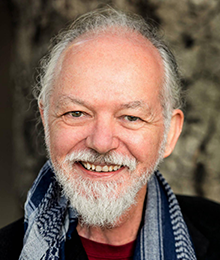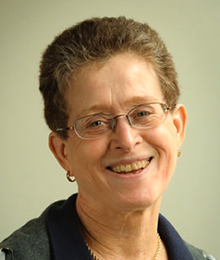Plenary Talks
The 2016 IEEE Haptics Symposium will include two plenary talks by eminent researchers in the field of haptics, with one speaker from haptic science and the other from haptic technology. We are delighted to announce that our two speakers will be Kenneth Salisbury and Roberta Klatzky. Each speaker will present in a single-track session in the early afternoon on Saturday or Sunday. Everyone interested in haptics will surely enjoy the opportunity to learn from these two luminaries.
Saturday, April 9, from 1:30 to 2:30 p.m. in Ormandy Ballroom
Title: Touching

Abstract: The common area of interest to attendees at this conference is physical interaction. Haptic and robotic technologies are beginning to merge into one discipline. Touching is the central theme that draws these disciplines together. Whether we are designing a surgical simulation to feel realistic or building a robot to cooperatively carry a load, we must make explicit choices about their mechanical behaviors. In part, this presentation will share our experiences and lessons learned in creating number of haptic and force controllable robotic systems. We will discuss measures of performance and mechanical means for maximizing them.
As haptically capable robots engage in more complex and sophisticated physical interactions with humans (HRI) we must consider how the robot's mechanical characteristics affect cooperative task performance as well as the affective effects when humans touch or are touched by a robot.
I find fascinating the dual meanings of touch and feel; both have physical and emotional interpretations and are inextricably linked in our language. The study of the emotional aspects of physical interactions between humans and robots is an area that warrants study. I will briefly discuss our own study of encoding and communicating emotional states through handshaking with a robot.
My taxonomy of physical interaction between a human and a robot has three levels of abstraction: 1) touching and being touched, 2) taking and giving and 3) leading and being led. At each level bi-directional energy exchanges occur. Behaviors during these interactions impact task outcomes as well as have emotional impact on the humans they touch. Robot characteristics such as impedance, frequency content, fidelity, and more have impact on quality of human/robot physical cooperation and the ensuing affective interpretations. In closing I will discuss our work on wearable robotics. Rather than addressing strength and rehabilitation, our study addresses interactivity, communication, emotional and cognitive issues that arise when a robot becomes part of our self.
Biography: Professor Salisbury received his PhD from Stanford in Mechanical Engineering in 1982. At MIT from 1982 to 1999, he served as Principal Research Scientist in Mechanical Engineering and as a member of the Artificial Intelligence Laboratory. Some of the projects with which he has been associated include the Salisbury (Stanford-JPL) Robot Hand, the JPL Force Reflecting Hand Controller, the MIT-WAM arm, and the Black Falcon Surgical Robot. His work with haptic interface technology led to the founding of SensAble Technologies Inc., producers of the PHANTOM haptic interface and 3D FreeForm software. In 1997 he joined the staff of Intuitive Surgical, in Mountain View CA, where as Fellow and Scientific Advisor his efforts focused on the development of telerobotic systems for the operating room. In the fall of 1999 he joined the faculty at Stanford in the Departments of Computer Science and Surgery, where his research focuses on medical robotics and surgical simulation, and the design for robots for interaction with and near humans. A spinout from his lab resulted in the founding of the personal robotics program at Willow Garage. In 2011 he was awarded the IEEE "Inaba Technical Award for Innovation Leading to Production". He has served on the National Science Foundation's Advisory Council for Robotics and Human Augmentation, as Scientific Advisor to Intuitive Surgical, Inc., and as Technical Advisor to Robotic Ventures, Inc., and he currently is a member of the Scientific Advisory Board at Magic Leap, Inc. He has also served as an expert witness in litigation in the fields of haptics and robotics, and as a member of the Board of Directors of AREON Flutes.
Sunday, April 10, from 1:30 to 2:30 p.m. in Ormandy Ballroom
Title: Haptic Perception Along the Road From Basic Science to Application
Recording Available At: https://ieeetv.ieee.org/ieeetv-specials/keynote-at-2016-haptics-symposium-roberta-klatzky
 Abstract: I did not enter the field of haptic perception; rather, I was thrust into it during the 1980s by Susan Lederman, who along with my colleague Jack Loomis, was one of the few psychological scientists who actually studied this arcane sensory system! In our early work, Susan and I demonstrated that objects could be quickly and easily identified by the sense of touch, and we described the purposive, active nature of exploration that served as the basis for this capability. This solid cognitive science happened to coincide with new developments in engineering and neuroscience that increased the visibility of haptics as a basic and applied research field and led to the first interdisciplinary conference of this type. Of course, attendees there could not begin to envision how interest in research on touch would develop into the dynamic scene we see today. My own interests in haptic perception have moved increasingly from the basic science with which I began to applications areas such as commerce, assistive technology, and surgical devices. My talk will describe this trajectory.
Abstract: I did not enter the field of haptic perception; rather, I was thrust into it during the 1980s by Susan Lederman, who along with my colleague Jack Loomis, was one of the few psychological scientists who actually studied this arcane sensory system! In our early work, Susan and I demonstrated that objects could be quickly and easily identified by the sense of touch, and we described the purposive, active nature of exploration that served as the basis for this capability. This solid cognitive science happened to coincide with new developments in engineering and neuroscience that increased the visibility of haptics as a basic and applied research field and led to the first interdisciplinary conference of this type. Of course, attendees there could not begin to envision how interest in research on touch would develop into the dynamic scene we see today. My own interests in haptic perception have moved increasingly from the basic science with which I began to applications areas such as commerce, assistive technology, and surgical devices. My talk will describe this trajectory.
Biography: Roberta Klatzky is the Charles J. Queenan Jr. Professor of Psychology at Carnegie Mellon University, where she is also on the faculty of the Center for the Neural Basis of Cognition and the Human-Computer Interaction Institute. She received a B.S. in mathematics from the University of Michigan and a Ph.D. in cognitive psychology from Stanford University. She is the author of over 300 articles and chapters, and she has authored or edited 7 books. Her research investigates perception, spatial thinking and action from the perspective of multiple modalities, sensory and symbolic, in real and virtual environments. Klatzky's basic research has been applied to tele-manipulation, image-guided surgery, navigation aids for the blind, and neural rehabilitation. Klatzky is a Fellow of the American Association for the Advancement of Science, the American Psychological Association, and the Association for Psychological Science, a Senior Member of the Institute of Electrical and Electronics Engineers (IEEE), and a member of the Society of Experimental Psychologists (honorary). For her work on perception and action, she received an Alexander von Humboldt Research Award and the Kurt Koffka Medaille from Justus-Liebig-University of Giessen, Germany and was an appointed an honorary ambassador by the Technical University of Münich. Her professional service includes governance roles in several societies and membership on the National Research Council's Committees on International Psychology, Human Factors, and Techniques for Enhancing Human Performance. She has served on research review panels for the National Institutes of Health, the National Science Foundation, and the European Commission. She has been a member of many editorial boards and is currently an associate editor of ACM Transactions in Applied Perception.

